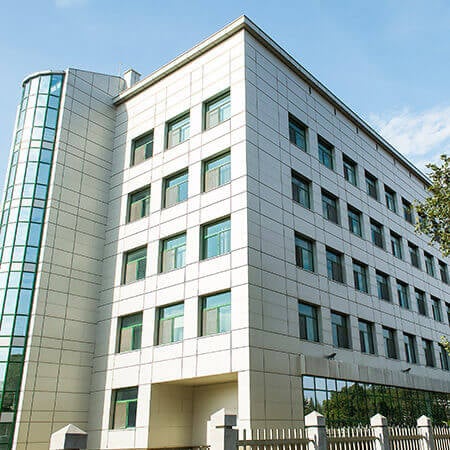Knee Arthritis III-IV Degree — Bilateral Total Knee Replacement: treatment in the Best Hospitals in the World
Treatment prices are regulated by national law of the corresponding countries, but can also include additional hospital coefficients. In order to receive the individual cost calculation, please send us the request and medical records.
Joint Replacement
- Hip replacement
- Total knee replacement
- Shoulder joint replacement
- Total elbow replacement
- Hip replacement in neck fracture
- Total knee replacement and rehabilitation
- Hip replacement and rehabilitation
- Bilateral hip replacement
- Bilateral hip replacement and rehabilitation
- Bilateral total knee replacement and rehabilitation
- Orthopedic rehabilitation

Department of Adult and Pediatric Orthopedics, Trauma Surgery, Foot Surgery, Hand Surgery and Rheumatology
The Department of Adult and Pediatric Orthopedics, Trauma Surgery, Foot Surgery, Hand Surgery and Rheumatology offers the full range of diagnostic and therapeutic services in its areas of specialization. The key areas of work of the department's doctors include large joint arthroplasty, arthroscopic interventions on the knee, hip, and shoulder joints, conservative and surgical treatment of foot and hand diseases and deformities, rheumatic joint lesions, orthopedic diseases in children, and musculoskeletal injuries. The key to successful clinical practice is the professionalism and unique experience of the department's medical team, combined with the advanced infrastructure and state-of-the-art equipment. The department has 5 operating rooms equipped with the latest technology. Most surgical interventions are performed using minimally invasive techniques, due to which, in the shortest possible time, the patient is verticalized, their mobility is restored, and a pronounced pain syndrome is excluded. The department annually performs more than 4,500 surgical interventions, including especially complex ones, so the specialists at the medical facility are rightfully proud of their impressive clinical experience in the surgical treatment of orthopedic diseases. Over the years, the department has gained an excellent reputation not only in Germany but also far beyond its borders.





Department of Adult and Pediatric Orthopedics, Trauma Surgery and Arthroplasty
The Department of Adult and Pediatric Orthopedics, Trauma Surgery and Arthroplasty provides the full range of medical services in the areas of its competence. The department's team of doctors treats patients with diseases and injuries of the musculoskeletal system, joints, bones, tendons, ligaments, and muscles. Orthopedists specialize in partial and total knee, hip, and shoulder replacement surgery, as well as successfully perform revision arthroplasty. Doctors perform arthroplasty at the EndoCert certified Maximum Care Center for Joint Replacement Surgery. The department also has the status of a regional Trauma Center Berlin-Brandenburg, where both common household injuries and severe multiple injuries are effectively treated. The department's team of doctors has a perfect command of advanced conservative and surgical treatment methods in the area of its specialization. Joint replacement surgery is performed here using minimally invasive techniques, which allows the patient to get back on their feet and get rid of pain as quickly as possible. The department has also gained vast experience in arthroscopic treatment of pathologies of large joints and injuries of the tendons, ligaments, and muscles. The department uses an innovative method of cartilage tissue restoration called autologous chondrocyte implantation. Patients of the medical facility receive personalized medical care in comfortable conditions.




Department of Trauma Surgery, Orthopedic Surgery and Foot Surgery
The Department of Trauma Surgery, Orthopedic Surgery and Foot Surgery offers the full range of modern diagnostic tests for the detection of musculoskeletal diseases, as well as many effective treatment methods for their elimination. Moreover, the department enjoys the status of the Center of Excellence for Trauma Surgery, so trauma surgeons working in the medical facility have a rich and unique experience in the treatment of patients after both simple common and especially complex injuries, including traumatic brain injuries, spinal injuries, polytrauma, injuries of the internal organs, etc. In addition to the treatment of injuries, a special focus is on arthroscopic interventions, joint replacement surgery, interventions to treat foot diseases and deformities, as well as surgery to resect soft tissue tumors. The surgical treatment is provided in the high-tech operating rooms with advanced surgical instruments and computerized systems for the most effective interventions with minimal damage to the healthy adjacent tissues.




The doctors in European hospitals successfully perform complex surgical interventions to replace two knee joints at once. This type of replacement surgery is called bilateral. Thanks to this surgery, even patients with severe arthrosis, who previously could hardly move around the apartment, can return to a full-fledged and active life in 3-4 months. To undergo treatment of bilateral gonarthrosis abroad, please use the services of Booking Health. We will select the best orthopedic center for you and organize your trip.
Content
- Who may need a bilateral knee?
- Types of bilateral total knee replacement
- Advantages of single-stage replacement surgery
- Advantages of two-stage replacement surgery
- Functional outcomes
- Surgery and rehabilitation
- Why is it worth having the surgery abroad?
- Treatment in European hospitals with Booking Health
Who may need a bilateral knee?
Deforming osteoarthritis of the knee joint is the second most common orthopedic disease after coxarthrosis. Gonarthrosis accounts for 25% of all cases of diseases of the musculoskeletal system. Many patients have two knee joints affected at once. It is in these situations that bilateral total knee replacement is required.
Bilateral gonarthrosis accounts for at least 20% of cases of this disease. But usually the lesion of one joint is dominant, while on the other the changes are less pronounced. The problem is that after knee replacement surgery, the load on the other leg increases dramatically. It is on it that a person transfers the entire weight of his body when walking. Therefore, in many patients, the disease progresses rapidly within 3 months after the surgery.
Consequently, if arthrosis on the second joint has reached at least grade 2, doctors recommend that patients have bilateral total knee replacement. Such an operation will provide a better quality of life for the patient due to the absence of pain and increased physical activity.
Bilateral total knee replacement is substitution of both knee joints with prostheses in people with bilateral knee arthritis.
Cost of bilateral replacement surgery starts from €28,700. You can find prices for other treatment options on the Booking Health website.
The best hospitals in Europe are:
- Hospital Kassel
- Vitos Orthopedic Clinic Kassel
- Academic Hospital DRK Berlin Westend
- St. Antonius Hospital Eschweiler
Types of bilateral total knee replacement
Bilateral total knee replacement can take place in one or two stages.
A single-stage treatment option assumes that within only one surgical procedure the doctor will implant two endoprostheses: one on the right and one on the left leg. Such an intervention is more traumatic, prolonged, and requires a longer hospital stay. The early rehabilitation period becomes difficult, since there is no possibility of support on the other leg when walking. But this approach also has many advantages: one surgery instead of two and one rehabilitation period instead of two.
In practice, two-stage bilateral total knee replacement is more commonly used. In fact, these are two different operations performed at different intervals. They usually range from 3 to 6 months. Sometimes the break is minimal – only 2-3 weeks. By its nature, such a replacement surgery is as close as possible to a single-stage one. In other situations, the break increases to several years, but this is mainly a choice of the patient, not the doctor, and usually it is associated with financial reasons.
Advantages of single-stage replacement surgery
The possibility of bilateral knee replacement within a single operation is attractive to many patients. It has many undeniable advantages:
- A person will undergo only one surgical procedure instead of two. This also means one stage of diagnosis, one anesthesia, one rehabilitation period. It is morally easier for a patient to decide on one operation than on two.
- Less time spent in the hospital. A person after the single-stage bilateral knee replacement stays in the hospital longer than after surgery to replace only one knee. However, with a two-stage approach, two such operations are required. Accordingly, the total hospitalization time with the single-stage method is reduced.
- Less time spent on rehabilitation. The full recovery of the knee joint after its replacement takes at least 3-4 months. Therefore, with a single-stage method, the gain in time spent on rehabilitation is very significant.
- The final result of the treatment can be achieved faster. After a single-stage bilateral knee replacement, a person can quickly return to an active life and completely get rid of chronic pain. The patient can forget about gonarthrosis after 4-6 months. With a two-stage approach, it is necessary to add a time interval between two operations to this date.
- The total cost of treatment is lower. It decreases by about 30%, excluding rehabilitation. As with the two-stage approach, the patient has to purchase two artificial knee joints. But he only pays for one surgery, albeit a more expensive one. The cost of diagnostics is also reduced.
Advantages of two-stage replacement surgery
In replacement surgery, the two-stage approach to bilateral arthroplasty is used more often than the single-stage one. This is primarily due to lower health risks. The main advantages of the two-stage method are:
- Less traumatic surgery. Its duration is shorter. The person loses less blood and is less likely to suffer from complications. In patients over 85 years of age with severe comorbidities, two-stage total knee replacement is considered the best option.
- Easier rehabilitation. There is a more or less healthy leg that you can lean on when walking with crutches. However, this advantage is conditional. With severe arthrosis, the condition of the diseased leg is comparable to that of the operated limb. In addition, modern rehabilitation centers use robotic systems that provide full rehabilitation even after a single-stage bilateral knee replacement surgery.
- Less one-time costs. Knee replacement surgery for one knee is cheaper than for both. The patient only needs to buy one artificial joint. As a result, the total cost of treatment will be 30% higher, but the person will have time to save money until the next surgery.
Functional outcomes
According to some studies, single-stage bilateral joint replacement surgery gives the best long-term functional outcomes. H. Husted with his co-authors found that the implantation of two endoprostheses at once within the single surgery provides:
- Better range of motion.
- Less pain.
- Less need for additional support when walking.
- Higher chances of returning to work.
- Higher activity levels.
- Higher levels of patient satisfaction with the surgery.
Apparently, this is due to the rapid progression of arthrosis on the opposite side after the first stage of the surgical intervention. The later the operation is performed to treat gonarthrosis, the worse the functional outcomes.
In addition, doctors often have to resort to other types of endoprostheses that have a shorter service life. For example, in case of mild osteoarthritis, they can implant an unconstrained endoprosthesis with a mobile-bearing platform. It provides the best knee function and has a maximum lifespan of tens of years. At the same time, with the progression of arthrosis, a partially constrained or even fully constrained prosthesis may be required. These artificial joints not only provide less range of motion, but also wear out faster.
Surgery and rehabilitation
The surgery is performed under general anesthesia or spinal anesthesia. The doctor removes the patient's own bone and cartilage structures, and then implants the components of the endoprosthesis in their place. Whenever possible, the ligaments are preserved. If all of them cannot be preserved, at least some of the ligaments are preserved with partially constrained prostheses. The more natural tissues inside the knee are retained, the longer the lifespan of the implanted artificial joint.
The single-stage surgery to replace both knee joints at once is difficult and time-consuming. It lasts 3-4 hours. A person loses a lot of blood, so he needs blood transfusion. He spends more time in the hospital than after replacing only one knee joint. But the general terms of rehabilitation are about the same: it takes 4-6 months to fully recover, depending on the patient's state of health and his requirements for functional outcomes.
After surgery, the early phase of rehabilitation begins. The person performs the first exercises while lying in bed. Then he works out on special simulators that help him to activate and work out his walking skills even in conditions when both legs are operated on.
After being discharged from the hospital, the person can undergo further recovery in a specialized rehabilitation center. The patient forms the correct walking stereotype, develops joints, builds muscles, trains balance and coordination. After 2-3 months, the person can walk without any support, and after 4-6 months, the maximum functionality of the lower limbs is achieved. The implanted endoprostheses will last for decades. If worn, they can be replaced.
Why is it worth having the surgery abroad?
Knee replacement surgery can be performed in any country in the world, but few doctors have extensive experience with the single-stage bilateral knee replacement. This operation is technically more difficult. It should be performed in specialized orthopedic centers.
To get the best result with minimal health risks, you can go to one of the foreign hospitals. Here are the benefits of treatment abroad:
- Not only two-stage, but also single-stage bilateral replacement surgery can be performed. This approach not only reduces the cost of treatment, but also allows having only one operation instead of two.
- The doctors working in modern, well-equipped rehabilitation centers will quickly "put the patient on his legs" even after the single-stage replacement of both knee joints.
- Minimal health risks: safe operations abroad are carried out even in the patients with severe concomitant pathology, aged 85-90 years and older.
- Artificial joints are implanted under the guidance of computer-assisted navigation. The perfectly accurate implantation with an error of no more than 0.1 mm reduces the risk of endoprosthesis loosening by 8 times.
- High-quality prostheses will last for decades. Only 10% of patients will require the second surgery for artificial joint replacement.
- Full rehabilitation allows the patient to permanently get rid of knee pain and return to an active lifestyle.
Treatment in European hospitals with Booking Health
To undergo treatment in European hospital, please use the services of Booking Health. On our website, you can see the cost of treatment in different hospitals, compare prices and book a medical care program at an affordable price.
Please contact the Booking Health specialists to undergo treatment in European hospital. Here are our benefits for you:
- We will select the best European hospital whose doctors specialize in bilateral total knee replacement.
- We will help you overcome the language barrier, establish communication with your attending physician.
- We will reduce the waiting time for the start of the medical care program and book you a doctor's appointment on the most suitable dates.
- We will reduce the price. The cost of treatment in European hospitals will be decreased due to the lack of additional coefficients for foreign patients.
- We will take care of all organizational issues: documents for entering the country, transfer from the airport, hotel, interpreter, etc.
- We will prepare a program and translate medical documents. You do not have to repeat the previously performed diagnostic procedures.
- We will provide communication with the European hospital after the completion of the medical program.
- We will organize additional medical examinations and treatment in European hospitals, if necessary.
- We will buy medicines abroad and forward them to your native country.
- We will help you keep in touch with the European hospital after the completion of the program.
Booking Health makes treatment in European hospitals easier, faster and cheaper. We will fully organize your trip, and you will only have to focus on restoring your health.
Authors:
This article was edited by medical experts, board-certified doctors Dr. Nadezhda Ivanisova, and Dr. Bohdan Mykhalniuk. For the treatment of the conditions referred to in the article, you must consult a doctor; the information in the article is not intended for self-medication!
Our editorial policy, which details our commitment to accuracy and transparency, is available here. Click this link to review our policies.

